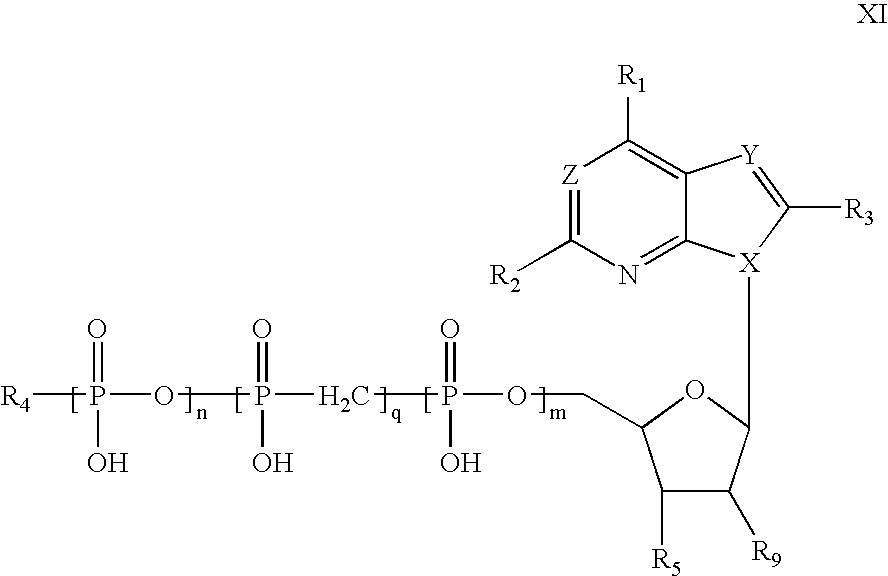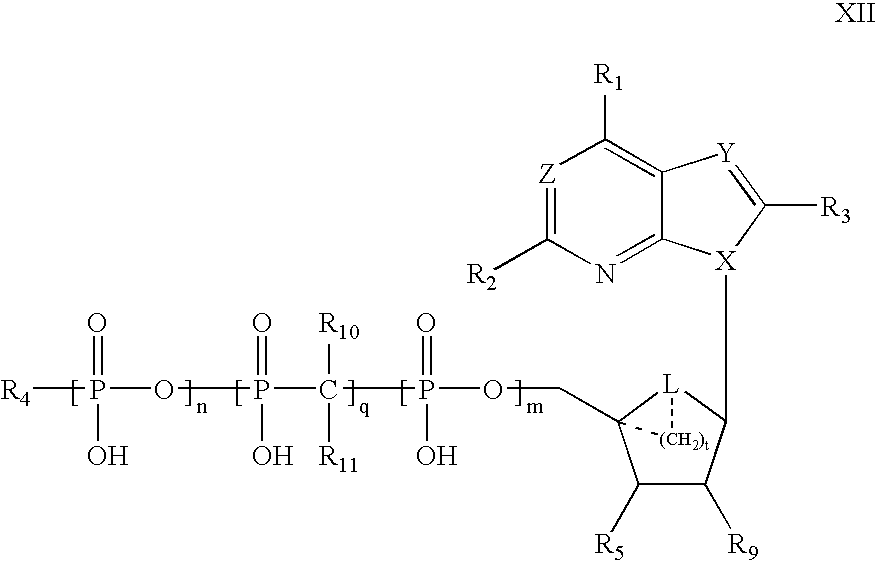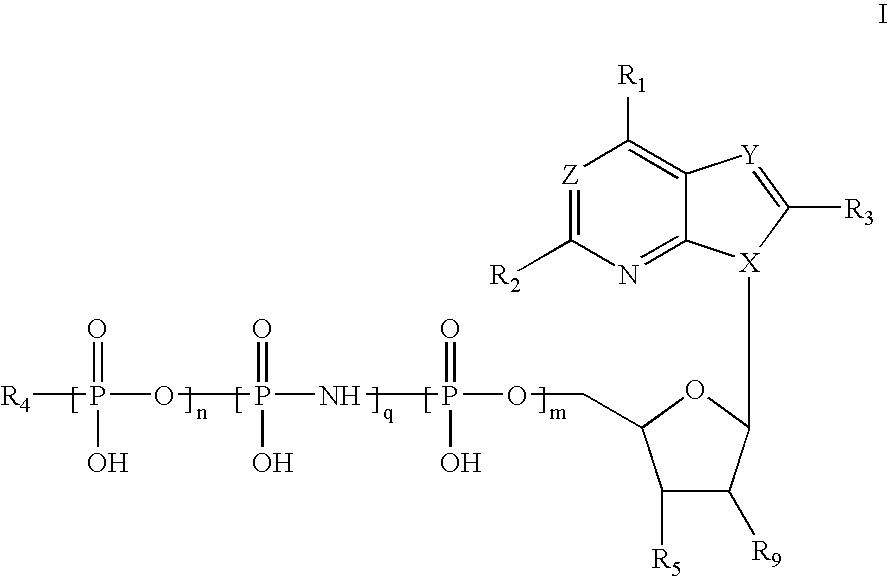Methods of treating heart failure with modified ATP, ADP and AMP compounds
a heart failure and amp compound technology, applied in the field of inotropic agents, can solve the problems of loss of efficacy, only effective adrenergic agonists, and significant limitations of each of the positive inotropic agents
- Summary
- Abstract
- Description
- Claims
- Application Information
AI Technical Summary
Benefits of technology
Problems solved by technology
Method used
Image
Examples
example 2
Intact Myocyte Binding with the P.sub.2-Selective Radioligand [.sup.35S] 5'-O-2-thiodiphosphate ([.sup.35S] ADP.beta.S)
[0151] Cardiac ventricular myocytes were prepared and incubated with progressively increasing concentrations of [.sup.35S] ADP.beta.S. The binding reaction is performed by the addition of a Dulbecco's Modified Eagle's Medium (which contains 1-glutamine and glucose but lacks phenol red, adenosine nucleotides, and sodium bicarbonate, buffered by HEPES, pH=7.4) containing [.sup.35S]ADP.beta.S (0.5 to 200 nM, for saturation isotherm study). Nonradioactive ADP.beta.S is used to define the level of nonspecific binding. Additional purinergic agonists or antagonists are added depending on the experimental conditions. Following a 30-minute incubation at 37.degree. C., cells are washed three times with 3 ml of ice-cold wash buffer (containing 120 mM NaCl, 5.4 mM KCl, 0.8 mM MgSO.sub.4, 1.8 mM CaCl.sub.2, 50 mM HEPES, and 1.0 mM NaH.sub.2PO.sub.4 adjusted to pH=7.4). One ml of...
example 3
Structure-Activity Relationships
[0154] Part I: A series of compounds was tested for the ability to stimulate an increase in myocyte contractility. The ability to produce a positive inotropic response was compared to the ability to inhibit the high-affinity binding sites for [35S] ADP.beta.S. FIG. 3 shows the EC.sub.50 values determined for each agonist stimulating myocyte contractility compared to the K.sub.i of the same agonists in inhibiting high-affinity [.sup.35S] ADP.beta.S binding. It can be seen that in general, the five compounds tested exhibit a strong positive inotropic responses which closely correspond to their Ki values.
[0155] Part II: A second series of compounds were treated as in part I above. Although the EC.sub.50 values for these compounds closely correspond to their Ki values, it can be seen from FIG. 4 that these compounds have a markedly diminished ability to stimulate myocyte contractility or to inhibit high-affinity [.sup.35S] ADP.beta.S binding.
example 4
Use of Cultured Chick Ventricular Cells and Adult Rat Cardiac Ventricular Cells as Models for the Characterization of Cardiac P.sub.2 Purinergic Receptor
[0156] Ventricular myocytes cultured from chick embryos 14 days in ovo and cells isolated from adult rat heart ventricles were used as novel cell models to characterize the cardiac P2PR. ATP caused a large increase in the contractile amplitude (maximal % increase=89.7.+-.9%, n=14.+-.SE), which was determined via a video motion detection system. ADP (47.7.+-.10%, n=8), AMP (9.6.+-.4%, n=7) and adenosine (15.+-.4%, n=24) were much less efficacious. To determine the subtype of P.sub.2PR involved, the ability of agonists selective at the .sub.P2 (ADP.beta.S and 2-methylthio ATP), P2.sub.x (.alpha.,.beta.-methylene ATP) and P2.sub.u (UTP) receptors to increase contractile amplitude were determined. The maximal percent increase was ADP.beta.S>2-methylthio ATP (76.+-.15%, n=7 and 54.+-.7%, n=17, respectively)>>UTP (22.+-.4%, n=7) or .alpha...
PUM
| Property | Measurement | Unit |
|---|---|---|
| volume | aaaaa | aaaaa |
| volume | aaaaa | aaaaa |
| mole fraction | aaaaa | aaaaa |
Abstract
Description
Claims
Application Information
 Login to View More
Login to View More - R&D
- Intellectual Property
- Life Sciences
- Materials
- Tech Scout
- Unparalleled Data Quality
- Higher Quality Content
- 60% Fewer Hallucinations
Browse by: Latest US Patents, China's latest patents, Technical Efficacy Thesaurus, Application Domain, Technology Topic, Popular Technical Reports.
© 2025 PatSnap. All rights reserved.Legal|Privacy policy|Modern Slavery Act Transparency Statement|Sitemap|About US| Contact US: help@patsnap.com



